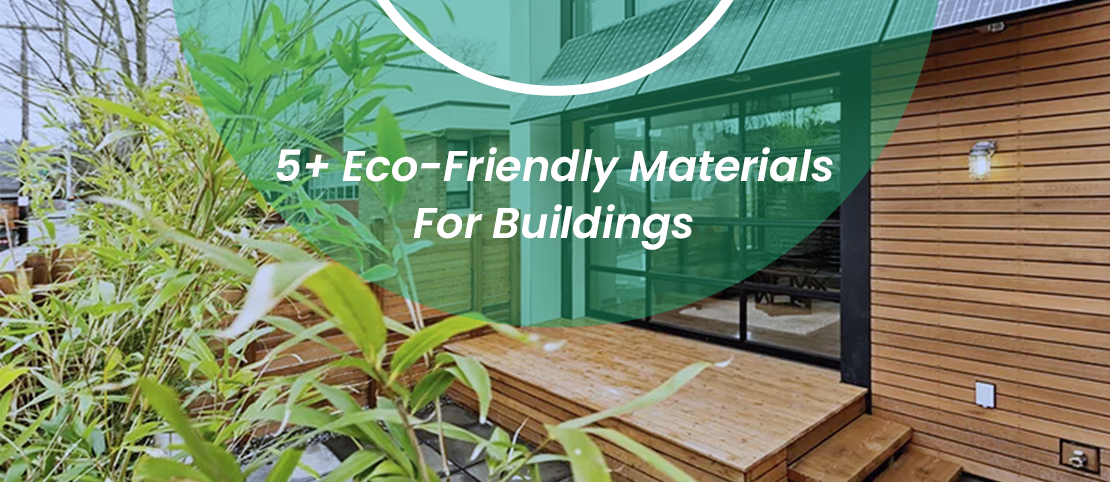5+ Building Materials That Help You Remain Eco-Friendly
As the world becomes more aware of the impact of climate change, there is a growing demand for eco-friendly building materials. Building materials are an integral part of construction projects, and their environmental impact can have far-reaching consequences. The good news is that there are now many eco-friendly building materials available on the market that can help reduce the environmental impact of construction projects.
In this blog post, we'll explore some eco-friendly building materials that are both sustainable and functional. These materials have been carefully selected based on their environmental impact, durability, and versatility. From natural wood to recycled plastic, each of these materials offers a unique set of benefits that can help make your construction project more eco-friendly.
Bamboo
Bamboo is one of the most popular eco-friendly building materials on the market. It's a renewable resource that grows incredibly fast and can be harvested in just a few years. In comparison, it takes many decades for a tree to reach maturity, making bamboo a much more sustainable option.
Bamboo is also incredibly strong and durable, making it a great choice for building materials. It can be used for everything from flooring solutions to structural supports, and it's even been used to create entire homes. Bamboo is also resistant to moisture and insects, making it an ideal material for outdoor use.
Solid Wood
Solid wood is a natural and renewable resource that has been used for centuries as a building material. When harvested and processed correctly, solid wood has a low carbon footprint and can be used for a wide range of building applications, including flooring, furniture, and structural supports. One of the key benefits of solid wood is its ability to store carbon, which helps reduce greenhouse gas emissions.
Additionally, solid wood is a highly versatile material that can be cut and shaped to fit a variety of design needs. When sourced from responsibly managed forests, solid wood can be a sustainable and environmentally friendly building material.
Straw Bales
Straw bales are an eco-friendly building material that's been used for centuries. They're made from the stalks of grain crops like wheat and rice, and they're incredibly cheap and easy to source.
When used in construction, straw bales provide excellent insulation and soundproofing. They're also incredibly fire-resistant and have a high thermal mass, which helps regulate indoor temperatures.
Recycled Steel
Recycled steel is another eco-friendly building material that's gaining popularity. Steel is one of the most recycled materials in the world, with a recycling rate of over 80%. Using recycled steel in construction helps reduce the need for new steel production, which is energy-intensive and produces significant amounts of greenhouse gases.
Recycled steel can be used in a wide variety of building applications, including framing, roofing, and insulation. It's incredibly strong and durable, and it's also fire-resistant, which makes it an ideal choice for areas prone to wildfires.
Hempcrete
Hempcrete is a relatively new building material that's made from the stalks of the hemp plant. Hemp is an incredibly sustainable crop that requires very little water and no pesticides. When mixed with a lime-based binder, hemp can be used to create a lightweight, insulating material that's ideal for walls and other structures.
Hempcrete is also incredibly breathable, which helps regulate indoor humidity levels and reduce the risk of mold growth. It's also fire-resistant and has excellent acoustic properties, making it an ideal material for soundproofing.
Cork
Cork is a renewable resource that's harvested from the bark of cork oak trees. The harvesting process is entirely sustainable and doesn't harm the trees, making it an eco-friendly choice for building materials.
Cork has excellent insulation properties, making it ideal for use in walls, floors, and ceilings. It's also incredibly durable and resistant to water and fire, making it an ideal choice for outdoor use.
Rammed Earth
Rammed earth is an ancient building technique that has become popular once again as people seek to build more sustainable structures. It involves packing a mixture of soil, sand, and clay into a frame, layer by layer, and compressing it until it hardens into a dense, solid wall.
Rammed earth walls have excellent thermal mass, which helps regulate indoor temperatures, and they're incredibly durable, with some structures lasting for centuries. The materials used are readily available and environmentally friendly, and the construction process has a low carbon footprint.
HDPE (High-Density Polyethylene)
HDPE is a versatile material that has a wide range of applications in the building industry, including as a building material for products such as decking, outdoor furniture, and playground equipment. One of the key benefits of HDPE is that it's highly recyclable, and can be made from recycled materials, which reduces the amount of waste that ends up in landfills.
HDPE is also lightweight and strong, making it an excellent material for outdoor applications where strength and durability are important. Additionally, HDPE is resistant to moisture, mold, and mildew, making it ideal for use in humid or wet environments. Overall, HDPE is a durable and eco-friendly building material that can help reduce the environmental impact of construction projects.
In Conclusion
The building industry has a significant impact on the environment, and it's important to take steps to reduce this impact. By using eco-friendly building materials, you can help reduce your carbon footprint and create more sustainable buildings. Whether you're building a new home, renovating an existing structure, or working on a commercial project, there are many eco-friendly building materials to choose from.
From HDPE to solid wood, these materials offer a range of benefits, including durability, versatility, and low environmental impact. By making a conscious effort to use eco-friendly building materials, you can help create a better future for our planet. So, consider these materials in your next project and take a step towards a more sustainable future.
Related Posts
Comments
By accepting you will be accessing a service provided by a third-party external to https://www.mbt-techserv.com/



